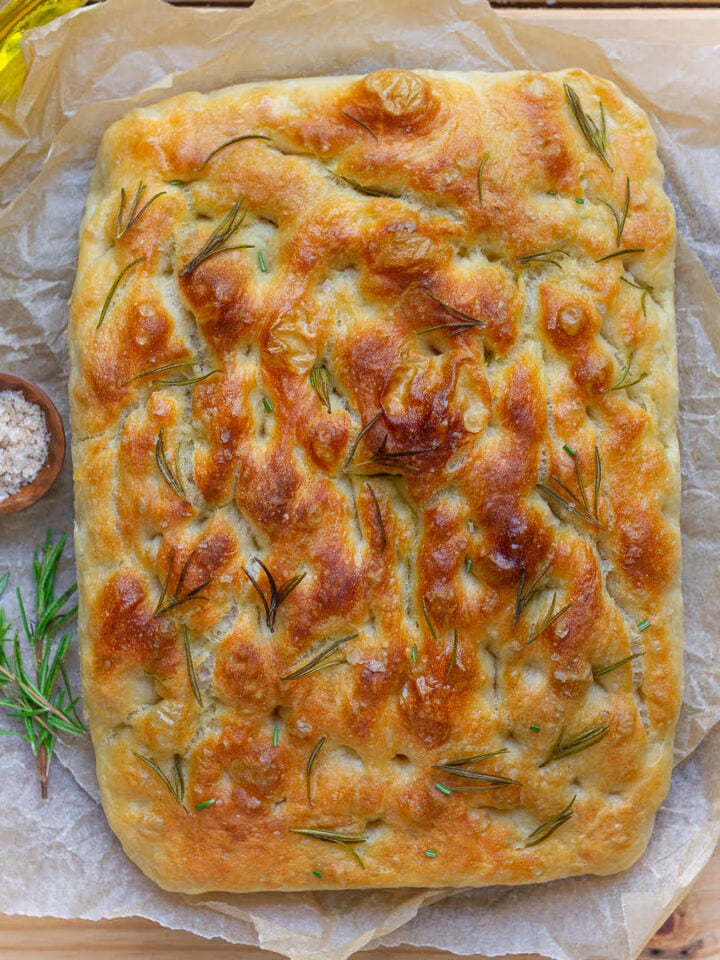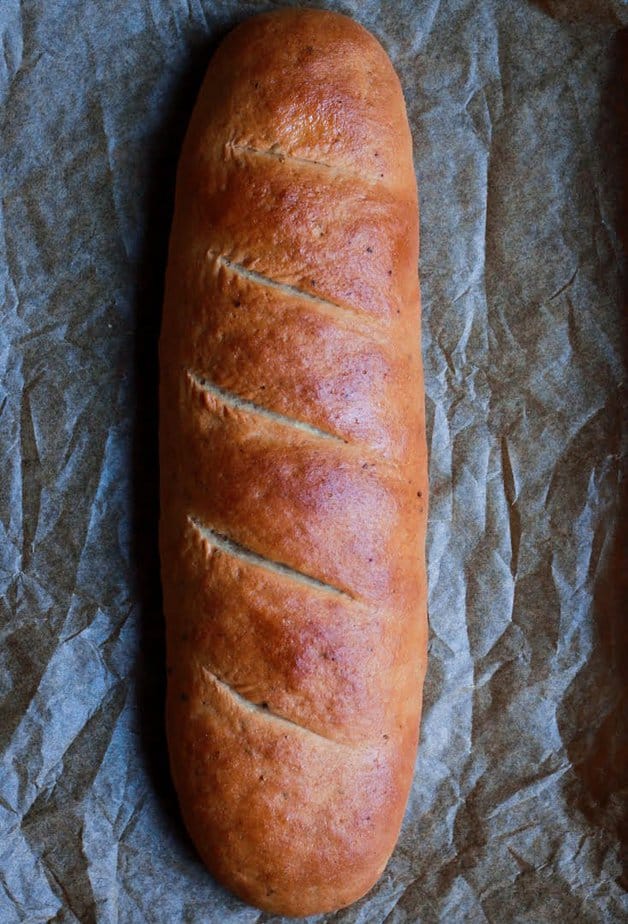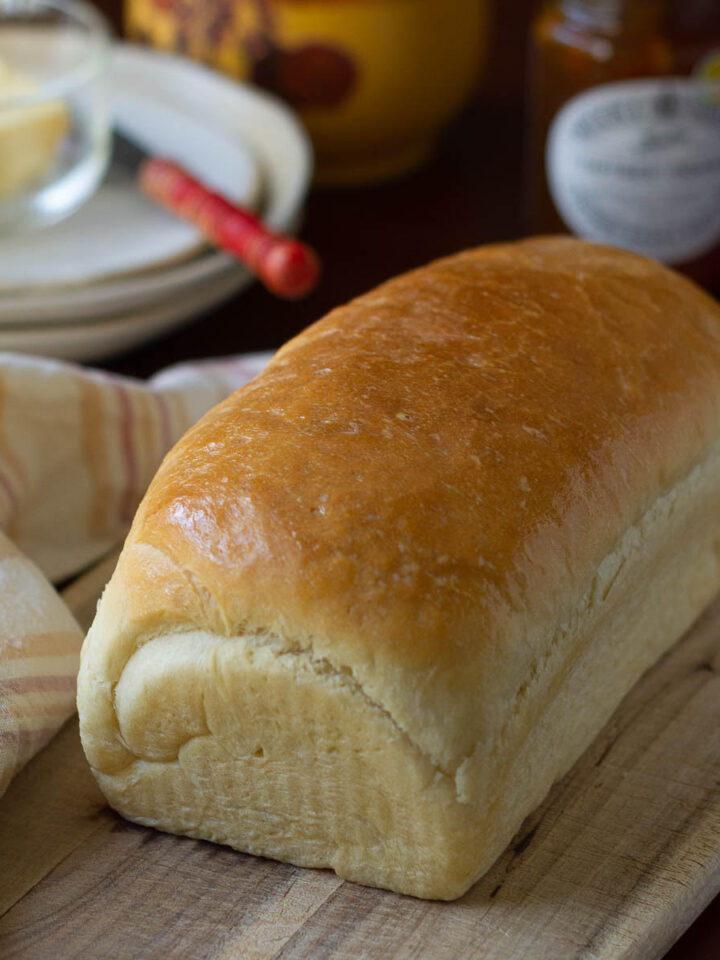Homemade olive bread is very moist, soft, rich-tasting, and has a lovely rustic look. Because it requires no technique and just 7 basic pantry ingredients (including water), it’s an easy recipe that even beginners can master.

Olive bread is perfect for those who love the idea of homemade bread but feel that kneading, shaping, and proofing are too much for them. This easy olive bread recipe is beginner-friendly, and if you’ve never stepped into the world of making bread at home, this is where you should definitely start.
Jump to:
Why you'll love olive bread?
Great for beginners: A basic bread recipe, whether you hand knead it (or use the stand mixer).
Absolutely delicious: The olive oil and the briny, salty essence of olives seep into the dough and make the homemade bread so flavorful!
Also very versatile: Use the homemade olive bread recipe as a base and switch up the add-ons and toppings according to your taste.

Recipe ingredients
Yeast helps the loaf rise. You can use dried active yeast or instant. I always like to activate the yeast in water before adding other ingredients to ensure that the yeast is active and will help the bread rise beautifully!
Water is my choice of liquid for this dairy-free bread. Use lukewarm water - not warm not cold - just slightly warm to the touch.
Sugar and salt help balance the flavors.
All-purpose flour makes for a great texture, but you can use bread flour or whole wheat flour for this homemade bread. The former will make a chewier bread and wholewheat will make a bit dense.
Olive oil gives the loaf a wonderful, delicious fruity flavor.
Olives Salty, briny olives take the flavor to 💯 Use whatever kind you have on hand, though Kalamata olives would be the best. I used green olives stuffed with pimentos and the bread was amazing!

How to make easy olive bread?
Step 1: In the bowl of a stand mixer, dissolve yeast and sugar in lukewarm water. Set aside for 5-10 minutes until the mixture is bubbly and frothy.
Step 2: Add the oil, salt, and flour to the yeast mixture. Mix with a spatula.
Step 3: Knead, using the dough hook, on low speed for 10 minutes, until the dough is smooth and elastic.
Step 4: If using your hands - Flour your work surface well, and turn out the dough onto it. Knead it till it is smooth and elastic, for about 12 minutes.

Step 5: Sprinkle the olives on top of the dough and knead them into the dough gently and briefly.

Step 6: Form the dough into a ball and transfer to a lightly oiled bowl. Cover and leave the dough proof in a warm, draft-free spot for 1-1.5 hours or until it doubles.
Step 7: Punch down the dough and turn it out on a floured surface. Knead it briefly and gently again.
Step 8: Shape the dough into a smooth ball and place it on a parchment or silpat-lined baking sheet.
Step 9: Cover the loaf loosely with a damp kitchen towel. Let it rise in a draft-free spot for 30-40 minutes until double in size.

Step 10: Preheat your oven to 250 C. Make a slash with a sharp knife or bread lame on the loaf. Put the tray in the oven and lower the heat to 220C. Bake the loaf for 30-40 minutes or until it is golden brown and sounds hollow when tapped on the bottom.

Step 11: Transfer the loaf to a wire rack and let it cool for at least an hour before slicing it.

Pro tips
- First, use a very sharp knife, bread lame, or blade to score the bread.
- Make the cut in one stroke and confidently (even if you’re doing it for the first time, fake the confidence. Trust me).
- After scoring, spray the easy olive bread dough with water. It gives the loaf a good oven spring, a lovely sheen to the crust, and makes it crunchy.
- If you love a soft crust (like me), cover the dough with a slightly damp kitchen towel as soon as it comes out of the oven.
- Finally, the best homemade olive bread needs to cool completely before you slice. I like to give it a 2 to 3-hour rest, but an hour or two will also do.

Variations
The best part about homemade bread with olives? There are endless ways you can top it. Kalamata olives, with their salty bite, are the traditional olive bread ingredient. I didn’t have them, so I used green olives stuffed with pimento, and they were lovely. I’d say use whatever olives are easily available to you:
- Pitted plain green or black olives
- Stuffed olives
Or try a different topping:
- Walnuts or pine nuts to make it nutty
- Chopped rosemary for rosemary olive bread
- Cheesy olive bread with cheddar, feta, or Asiago cheese and olives

How to serve?
Warm and crusty, olive bread loaf is the kind you can serve plain or:
- With some good-quality olive oil
- A mixture of balsamic vinegar and olive oil
- Maybe a small salad to feel like a domestic goddess!
- Or with dips like gochujang mayo, creamy whipped feta, or tzatziki.
- You can toast it and smear it with butter or use it for making a sandwich or bruschetta.
- Serve it alongside a creamy soup.

FAQs
Dried-active, or instant, both types of yeast will work in this Moroccan olive bread recipe. Just remember to bloom it before you add other ingredients. If the yeast expands and bubbles, it is active and good to use.
It stays flavorful and moist for 3 to 4 days in the refrigerator, wrapped in cling wrap, or an air-tight container.
Yes, you can. Slice it. Wrap it well and freeze for up to 2 months.

More bread recipes
Video
Half the joy of cooking is sharing it with others. That’s why I’m always eager to hear from you. So go right ahead & drop a comment or reach out on Instagram, Pinterest, YouTube, or Facebook. I hope you love this olive bread as much as we do!
📖 Recipe

Easy Olive Bread
Ingredients
- 2.5 tsp Dried active yeast
- 1 tsp Sugar
- 1 cup Water, lukewarm
- 3 cups All-purpose flour
- 1 tsp Salt
- 2.7 ounces Olive oil
- 3/4 cup Olives, pitted and coarsely chopped
Instructions
- In the bowl of your stand mixer, dissolve yeast and sugar with the lukewarm water. Let stand for 5-10 minutes until foamy.
- Add the oil, salt, and flour to the yeast mixture. Mix with a spatula until a rough ball forms.
- Using the dough hook, knead for 10 minutes on low speed until the dough is smooth and elastic.
- Sprinkle the olives on top of the dough and knead them into the dough gently and briefly.
- Form the dough into a ball and transfer to a lightly oiled bowl. Cover and leave the dough to rise in a warm, draft-free spot for 1- 1.5 hours or until it doubles.
- Punch down the dough and turn it out on a floured surface. Knead it briefly and gently again.
- Shape the dough into a smooth ball and place it on a parchment or silpat-lined baking sheet.
- Cover the loaf loosely with a kitchen towel and let it rise in a draft-free spot for 30-40 minutes or until it doubles in size.
- Preheat your oven to 250 C. Make a slash with a sharp knife on the loaf. Put the tray in the oven and lower the heat to 220 C. Bake the loaf for 30-40 minutes or until it is golden brown and sounds hollow when tapped on the bottom.
- Transfer to a wire rack and let cool for at least an hour before slicing the bread. Enjoy!









Leave a Reply